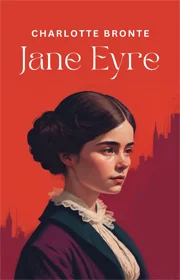
“Jane Eyre” follows the life of an orphan, Jane, who faces adversity and discrimination in her early years. She becomes a governess at Thornfield Hall, where she falls in love with the complex and mysterious Mr. Rochester. As their romance develops, secrets from Mr. Rochester’s past threaten their happiness. The novel explores themes of love, morality, and the pursuit of independence, making it a timeless classic in English literature.
Read Jane Eyre Flipbook:
Listen to Jane Eyre Audiobook:
Title: Jane Eyre
Author: Charlotte Brontë
Genre: Gothic fiction, Bildungsroman (coming-of-age novel)
Setting: 19th-century England, primarily at Lowood School and Thornfield Hall
Protagonist: Jane Eyre, an orphan with a strong sense of independence and moral integrity
Plot Summary:
• Orphaned at a young age, Jane endures a difficult childhood at Lowood School.
• She becomes a governess at Thornfield Hall, where she encounters the mysterious and brooding Mr. Rochester.
• A complex love story unfolds between Jane and Mr. Rochester, but dark secrets threaten their happiness.
• Jane faces moral dilemmas and personal growth as she strives for independence and self-respect.
Themes:
• Social class and gender roles
• Morality and integrity
• Love and independence
• The gothic elements of mystery and suspense
Notable Characters:
• Jane Eyre: The resilient and principled protagonist
• Mr. Rochester: The enigmatic and conflicted master of Thornfield Hall
• Bertha Mason: The mysterious and troubled first wife of Mr. Rochester
• St. John Rivers: A clergyman with significant influence on Jane’s life
Author’s Style:
• Brontë’s writing is characterized by vivid descriptions, emotional intensity, and a keen examination of social issues.
• The first-person narrative provides insight into Jane’s thoughts and emotions.
Legacy:
• “Jane Eyre” is considered a classic in English literature, praised for its exploration of complex characters and social issues.
• The novel has been adapted into numerous films, plays, and other literary works.
Impact:
• Brontë’s portrayal of a strong, independent female protagonist challenged societal norms of the time.
• “Jane Eyre” has had a lasting impact on feminist literature and discussions about gender roles.
Quotes:
• “I am no bird; and no net ensnares me: I am a free human being with an independent will.”
• “Reader, I married him.”